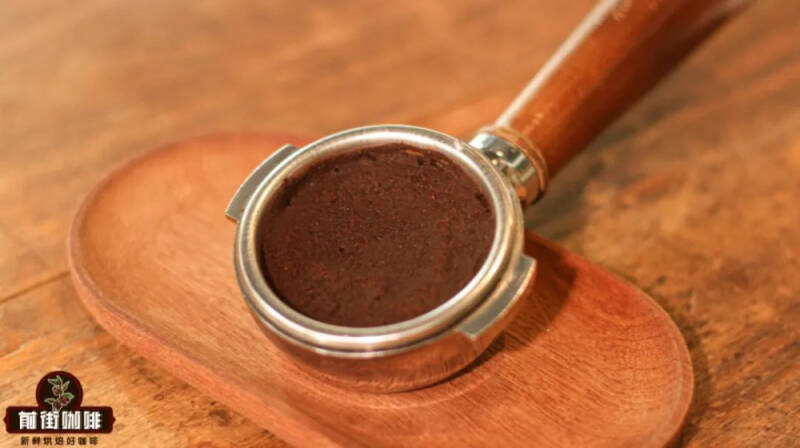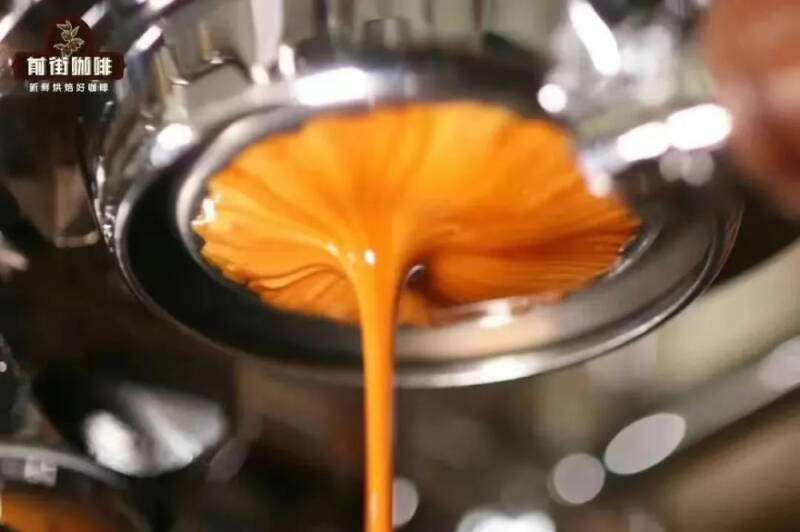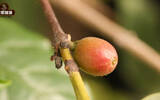Is there a hole in the pressed powder of espresso? Is it the channel effect? What is the channel effect of espresso?
The word "channel effect" often appears in articles on Qianjie! So I believe that when we are usually concentrated in the extraction, we will more or less encounter the channel effect! For example, there are some holes in the surface of pressed powder after the concentrated extraction, or the phenomenon of sputtering and skewed water column when using bottomless handle. This is all telling: the channel effect has appeared!

What is the channel effect? As we all know, water is "inert", and its flow direction is always the easiest way to go. The generation of channel effect is inseparable from the inertia of water. In the extraction process of making espresso, the coffee pressed powder pressed in the powder bowl is like a dense plane, which hinders the flow of water to a certain extent. Because the density is roughly the same everywhere, it is difficult for water to find a breakthrough. To break through this plane, water can only penetrate down uniformly and slowly along the pressure.

But if there is a lower density part of this "plane", then the water will concentrate and run to this low density place with inertia! This is the channel effect.
What are the consequences of the channel effect? It is reasonable that in the absence of a channel effect, hot water will evenly permeate all coffee powder, so that they can be reasonably extracted. However, after the emergence of the "channel", all the hot water that should have been extracted from coffee powder in other places flowed to this channel, which led to insufficient extraction of coffee powder that had not been infiltrated by water. And the coffee powder in the channel due to soaking too much hot water, resulting in excessive extraction! So, in the end, it will be a thin, acerbic espresso!
The phenomenon of the channel effect is like what we said at the beginning, the channel effect can be seen by us after it is produced! The reason why Qianjie prefers the use of bottomless handles, a large part of the reason is that we can see the extraction process of coffee, so that we can find and solve problems in time!
If you are using a bottomless handle, under normal extraction conditions, the coffee liquid will gather from the bottom of the bowl to the center, forming a vertical column of coffee liquid with a very uniform flow rate.
However, if the channel effect is produced in the extraction process, then in addition to the sputtering and skew of the water column described at the beginning, there will be unstable flow velocity and multiple liquid columns at the same time! After the completion of the extraction, there is a small chance of holes of different sizes. Their appearance will lead to the deviation of concentrated taste, so we have to start to solve the problem!
The cause of the channel effect 1. Coffee powder caking as said yesterday, static electricity is the main culprit leading to coffee powder caking. If we use a large number of caked coffee powder directly in concentrated extraction, it is very easy to lead to channel effect! Therefore, it is a very good choice to break it up with cloth powder needles or other needles.
2. Cloth powder is also a very important thing. If we just use our fingers to smooth it, then the amount of coffee powder in each place of the powder bowl must be different, and different powder amounts create different densities. Different densities make the "channel" easier to produce. Therefore, we need to use the powder distributor to distribute the powder evenly!
However, it should be noted that the height of the powder distributor is best adjusted according to the capacity of the powder bowl. Do not be too long or too high to make it a "powder press" that can press powder. In this way, it is easy to press the powder directly when distributing the powder, so it is no different from using hand cloth powder!
3. Pressing powder is the last link! We need to press the uniformly distributed but loose coffee powder into a denser pressed powder, so that it can be put into use.
But the strength of the powder is also important, if the force is uneven, it will cause pressed powder to become a ups and downs "valley". The water flows lower, directly forming a larger channel! Therefore, when pressing powder, the best direction of force application is to focus on the center, so that the maximum force error can be reduced.
-END-
Front Street Cafe
No. 10 Baoqian street, Yandun road, Dongshankou, Yuexiu district, Guangzhou, Guangdong province
Important Notice :
前街咖啡 FrontStreet Coffee has moved to new addredd:
FrontStreet Coffee Address: 315,Donghua East Road,GuangZhou
Tel:020 38364473
- Prev

What kind of yellow bourbon is arabica? What does it have to do with a red bourbon pickup?
As we all know, coffee beans are the core of coffee fruit! After the coffee fruit ripens, the farmers pick it and remove the beans for post-processing. Most mature coffee fruits are distinguished by their gorgeous red appearance! They also earned a delicious nickname-"coffee cherries."
- Next

Introduction of coffee history, coffee producing areas and coffee varieties in Uganda, an African country
Uganda is a country located in eastern Africa, straddling the equator, bordering Kenya to the east, Tanzania and Rwanda to the south, the Democratic Republic of the Congo to the west and South Sudan to the north. Most of the country is located in the East African Plateau, many lakes, the average elevation of 1000-1200 meters, known as "plateau water village". Uganda is tropical steppe.
Related
- What effect does Italian American coffee with filter paper have? Will coffee taste better if it is put on filter paper at the bottom of the powder bowl?
- What is the color difference in coffee beans? What are the characteristics of honey processed coffee beans? Why are the anaerobically treated coffee beans uneven in color?
- How does novice Xiaobai quickly get started and make coffee? Newbies learn to make coffee by hand and share the specific steps and process process!
- Costa tea has a shelf life of 100 years?! Expert: Unable to verify
- It's a huge uproar! American milk addition was rejected by Manner employees?!
- Mocha pot coffee bean recommendations| How fine and how much powder should be used for grinding? What parameter ratios do I need to use to make milk with Mocha pot coffee?
- What are the characteristics of the world's top ten coffee beans treated with Costa Rica honey? How to make black honey kadura from Tarazhu Pilon Processing Plant taste good?
- How to make deep-roasted coffee? What grinding water temperature does authentic Jamaica Blue Mountain No. 1 coffee use to brew it well?
- Selected high-grade rose summer coffee flavor tasting guide Why Panama rose summer has the aroma of flowers and fruits
- What equipment does a novice Xiaobai need to buy to learn to make coffee? Filter cup electronic scale bean grinder manual flushing pot purchase guide

